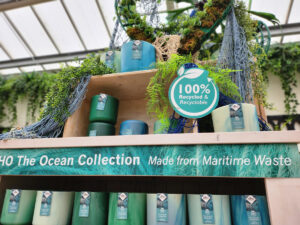Into the future with retail
By John Stanley and Sid Raisch
While the COVID years of 2020/21 seem to be in the distant past, the challenge now is what is ahead? It is difficult to forecast trends in a market that is changing so rapidly, but somebody has to start the conversation.
A year after co-founding the Global Garden Retail Conference in 2022, Sid Raisch, American consultant and John Stanley, International and Australian based consultant sat down and decided to advance the conversation on the future. Their network covers almost all of the global horticultural industry, hence this is a global forecast rather than a regional forecast. The following are their perspectives and thoughts.
“If you are not average, you are going to have a great future in horticulture”
We begin with this bold declaration so readers are properly prepared for the adventure ahead. This is not going to be your usual tour de garden centre ideas article. We are throwing down the gauntlet to the challenging situations in our future together. It is time to open a real dialogue on what is to be, and commence leapfrog evolving as if we are turning from apes to mankind. The consumer is a “different animal” than just three years ago and is rapidly becoming even more different in the way they shop for goods and experiences. We need to recognise these changes in order to be there with them on their journey. Will you join us?
The communications chain
The industry used to have a long communications chain that started with the propagator who sold plants to a nursery, who may then sell on to a distribution nursery and then they would sell to a garden centre who would sell the plant on to a consumer. The chain could be over four organisations long and the original grower got lost in the chain.
This was not something that was unique to horticulture. Agriculture had the same long supply chain where the farmer got lost in the chain.
The farm industry has made large strides forward, and now in progressive retail outlets it is the farmer who is the hero rather than the retailer. The result is the retailer has often become the storyteller on behalf of the farmer for consumers who want to know where their food is coming from.
The same should be true for the nursery industry. We should be promoting the grower and telling their story. This is happening occasionally, but there is a big opportunity for independent retailers specifically to be seen as a partner with local growers.

Sustainability is key – What is the Question?
If we are going to be the “green” industry moving forward, we have to make some major changes to be truly relevant and not exposed to be “greenwashing”. Is our industry only one, or maybe two public relations disasters in the spring peak of our business away from a total meltdown? We say this in relation to our direct contributions to landfills and ocean dumping of horticultural waste! How green is that? Are we shipping our waste, cleverly disguised as “packaging” around the actual product and with our names all over it, to the consumer as a burden they take on to dispose of? How can we defend ourselves in real time in a meltdown of controversy that could occur over this?

We have to become a plastic-free industry and the disposable, even recyclable black, white, and branded plastic pot will become an item of the past. We already have pot suppliers developing containers out of sheep’s wool, maritime waste, corncobs, cork, and of course we can go back to the past and use terracotta pots.
The other challenge is what we often grow the plants in. Peat is now a dirty word in the UK and in the US, and the same is true for native forest wood mulch in Australia. The industry can’t seem to get ahead of this issue no matter how much positive spin is applied.
Alternatives to soilless mediums now have to be found, and found quickly. Companies are looking at rice husks, oat husks, coconut-based materials, expanded clay, bentonite (natural clay), perlite, pine bark, and xylitol (lignite), amongst other products as plant growing media. Many of these are conceptually sustainable, but what about the transportation and carbon footprint of that? Composting local food waste and other natural materials is of growing interest and will become more important, or will there be other solutions? Should we turn the focus on this end-game first?
One thing is clear, the commercial nursery will be going through some major changes over the next few years.
Among their challenges is keeping up with inflation to ensure that profit margins are maintained. The industry has been bad at this in the past and we hope those lessons have been learned.
What is the answer to inflation? We have to take advantage of the new level of perceived value of the products of our industry and charge more for that in order to make ends meet. Production costs go up and can be squeezed only so much. The answer is to increase wages, grower family profits, and prices in lockstep. But we have to start paying closer attention to how we create a higher value product as perceived by the consumer. Then we must be willing to charge enough for it to sustain a healthy business model, building our bridge to the future.
What about the customer?

Generation X numbers around 65 million, while Baby Boomers and the Millennials (GenY) each have around 72 million members. Baby Boomers will begin shrinking through attrition in coming years. The new generations are demanding a different approach in their consumption of our industry’s products, and also in the opportunities for those who wish to be employed in it.
During COVID, consumers were locked in isolation and, desperate to escape, they purchased plants online to cheer themselves up. Now that they can escape, they are looking for experiences that align with their personal beliefs. They are now travelling overseas less and the authors believe that this will not change quickly due to failing economies, the price of airfares, and security concerns.
Young consumers want to be in a community with their peers, but need to get out of the city, and are now looking for rural escapes together. Rural garden centres who provide the right consumer package are becoming one of the benefactors. While internet ordering of plants shipped from who knew where grew rapidly during COVID, that growth has levelled, and it will be interesting to see if the carbon footprint of shipping plants that were purchased online will be tolerated as easily. However, shifting the buying process online will continue, but for local pickup, which is enhanced by the experience of the expedition and pilgrimage to the more distant garden stores.
The key is that the consumer is looking for an experience, rather than just a product. The product becomes the trophy of the experience.
The garden centre of the future
Over the past decades we were building destination garden centres. That model will be difficult to build in the future, mainly because of International Building Codes and planning regulations, and the cost to have all the boxes ticked before you can start a build. The owners, now and in the future, will need to reinvest in their garden centres to create freshness and appealing appearances. That is when this model will become challenging. New-build garden centres will be from a completely different model. Adaptive and creative reuse of facilities formerly used for other purposes, as well as up-fitted aging garden centres and nurseries, will be a more sustainable method than developing raw land from scratch. But will these be garden centres at all?
New retailers will need to focus on their target market. One of the best examples is “The Motorist” near Leeds in the UK. This model focuses on motorists and sells car auto parts, but the key is the restaurant and theatrical displays. This model of presentation is ideal to tailor for the future garden centre.
One of the positive factors in the sector is the amount of young people entering the industry and focusing on establishing retail plant centres. This will increase and will help keep the industry dynamic.
What will change?
Garden retail outlets will have less of:
- Shelves of garden chemicals as more consumers resist them.
- Less of anything mass produced in factories in Asia.
- Less giftware, and home and garden décor, and hardware that can be purchased in big box stores of all kinds.
They will have more of:
- Food services. This is a growth category with 20% growth in some countries. They are especially successful where they have a great view onto the countryside or a garden. The food offer can make up at least 20% of sales. In addition to traditional formats, food truck parks will be a means to this end.
- Markets and food halls selling local produce and local maker produced goods.
- Plants that are ‘romanticised’ rather than on a grid layout of rows of plants. This is one of the biggest opportunities we have; consumers will engage with the theatre and will buy into the stories.
Marketing
We all know social media is the way forward, but TikTok?
John Stanley was sceptical of the value of TikTok. However, plants are being purchased by younger people and they are using TikTok. Presuming security concerns of government are addressed adequately, this will continue. The average TikTok user spends 52 minutes a day on the app and it has 1 billion monthly activities.
Groovy Plant Ranch was encouraged by Sid Raisch, and then by their young staff to promote the business, and especially the plants, on TikTok. This led to quickly doubling the business, largely with a new audience of younger consumers who travel further to get there. Those young consumers view the journey as much a part of the social experience as the destination, or what they buy once they arrive. John has done the same at Chestnut Brae (an agritourism destination based on chestnut farming), getting the young backpackers to promote the business via TikTok.
TikTok is now mainstream, and it is time for PlantTok. BookTok, short for Book TikTok, is a community of users on TikTok who are passionate about books, has over 13 billion users and recommends books to friends. As a result, booksellers have come on board.
The future
“If you are not average, you are going to have a great future in horticulture.” There it is again, that bold statement that may have got your attention at the beginning of this article. Yes, average is not going to be a good place in the future, when consumers have moved ahead to doing business where they want, when they want to, with whomever they bring with them.
If you hate and resist change it is going to be a challenge for you. But, if you hate change, yet embrace it, until it becomes you, there is a great future for you in horticulture. The innovation is out there. It just happens to be coming from unlikely places where you wouldn’t normally see it or hear about it. Except you just have! We will have more for you on our journey together. Now, what will you do?
The future is what we make ours to be, as long as we’re aware of where the consumer is looking, and endeavour to not just meet there, but to invite them there, as a Garden Retailer (not garden centre) of the future.
Images supplied by John Stanley and Sid Reisch

